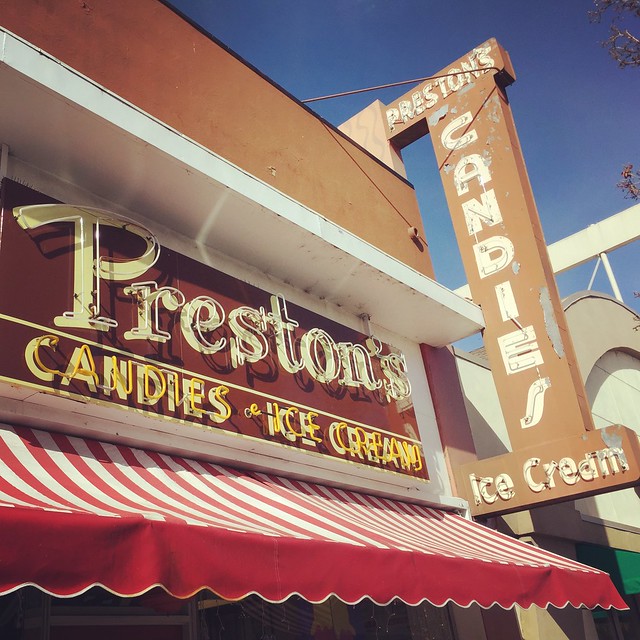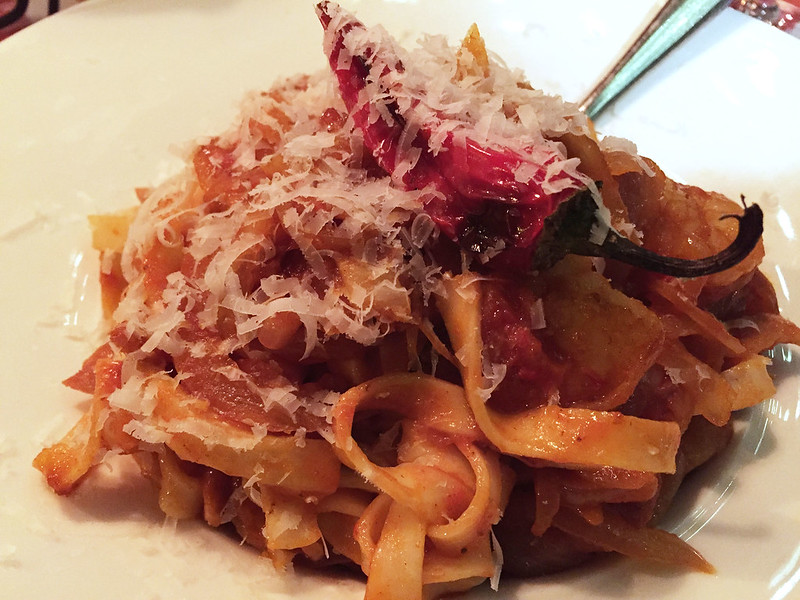Thursday, 1 February, 2018. 16:59
On the BART train again, ready to head back into San Francisco after another interesting day at the conference. We got up and had cereal as usual this morning before I left. M.’s plan was to go to the International Museum of Art, just a block down Market Street from our hotel, and then head over to Cow Hollow, either by walking, or catching a bus.
I arrived at the conference and checked the schedule boards in front of the rooms, to notice some changes to the program I’d organised on the online schedule planner. The first talk I wanted to attend at the Human Vision & Electronic Imaging (HVEI) conference had been moved 20 minutes earlier, overlapping the end of the very first talk I’d planned to go to, which was about image sensors for automotive cameras. So I went to the first half of that and then had to leave partway through to make sure I didn’t miss any of the HVEI talks. The sensor talk was by Boyd Fowler, who is a good speaker, but his subject is always very technical details of sensor chips, often down to the transistor and capacitor level, and this talk was no exception. Which is fine for people into that stuff, but it’s not my cup of tea, so I didn’t mind leaving a bit early.
As it turned out, the first HVEI talk was given by the same woman who gave the talk I reacted poorly to last year. As last year, she spent the first part of the talk building up how wonderful she was. She said that not only was she a cognition scientist, but she also founded a theatre production company and has written a bunch of plays and produced several short films, as she showed a slide with shots of some of her productions, oh and she also writes music too. Then she talked about human/robot interaction and showed a slide with two images of women having dinner with and playing chess with a humanoid robot. She said she deliberately chose pictures with women and not men because wouldn’t it be wonderful if in the future there were just women and robots and no men, ha ha.
Then she proceeded into her thesis for this presentation, which was that basically everyone doing artificial intelligence and machine learning (ML) was doing it wrong, because humans aren’t like machines and they behave unpredictably. She said people don’t learn by being shown labelled training sets (which I dispute actually, as children learn what a cat is by being shown cats or pictures of cats and being told that it’s a cat, until they learn that semantic connection), so using labelled training sets for ML is just wrong. She said in situations like driving in city traffic, people take risks and break rules all the time, so training driverless cars not to take risks and not to break rules is wrong. (Afterwards I heard her having an argument with a guy who does autonomous vehicle work, and he said they can’t make cars that take risks and break rules, because the law and the government would come down on them like a ton of bricks. She responded, “well, we need to change the laws.”) Basically her whole talk was that everyone doing ML research was doing it wrong and she had all the answers, if only they’d listen to her. I try not to dislike people, but both times I’ve seen this speaker, she’s come across as rampantly egotistical and convinced of her own superiority. She’s obviously smart and artistically talented, but it feels like she honestly believes she knows the answer to everything.
Anyway, the next talk was much nicer, by the same woman who gave the talk last year on teaching blind people to draw by copying raised outline images from memory, and showing how it improved their spatial awareness and increased connections to the visual cortex in their brain. She’s continued by teaching people to draw with their non-dominant hand in the same way. After a week of training their ability improves, and using fMRI she showed that it produces significant changes in the dominant brain hemisphere, suppressing activation of the motor cortex there. She showed that with some simple training it’s possible to vastly improve the non-dominant hand coordination of people after decades of use of their dominant hand.
The next talk was about how people study human perception of art. Normally human visual perception studies are done in a very controlled laboratory environment, because you want to be able to eliminate variation from things like light sources and surrounding objects and distractions. So most visual studies are done with viewers sitting at a desk in a dark room with a computer screen in front of them at a fixed distance, usually about half a metre. Images are displayed for maybe 5 or 10 seconds and the person has to indicate which one they like better or whatever, and then they go on to the next one, to get through as many as possible in a short amount of time. But this is not how people interact with art in reality! To get a handle on that, the speaker did an experiment in an actual art gallery, getting students to watch visitors, unknown to the visitors, and record how they looked at the art. He found that on average people spend almost a full minute looking at each painting. And 55% of people go back to a painting to look at it again later. They stand a range of distances away, from less than a metre, to 4 or 5 metres, averaging about 1.5. And the other thing is they visit galleries in groups, with friends, and they discuss the art with them. So experiencing art is a social event. It’s completely different in almost every aspect from looking at images on a screen in a lab. His conclusion was that although lab experiments can tell us important things about human vision and how it interacts with art, it can’t tell us the whole story and we need to do experiments in the wild as well before we can hope to fully understand how people interact with visual art.
Another talk was about the material appearance of grapes in 17th century Dutch master still life paintings. Seriously. They painted a lot of grapes, and they vary in their levels of realism, and also other aspects such as appearance of glossiness, juiciness, mould blooming, smoothness, 3D roundness and so on. Nowadays we know perception of things like material gloss depends on such measurable things as the size, brightness, sharpness of highlights. But back in the 17th century there was also an artist named Beurs who wrote an instructional book on painting, including tips on how to paint various objects, such as people, flowers, trees, and yes, grapes. He gave explicit instructions on how to shade the paint to make them seem round and how to add highlights to make them glossy. So the speaker did an experiment by cutting out the grapes (digitally) from a range of Dutch paintings, and getting viewers to rate them on glossiness, roundness, and so on. Then she measured the size, colour, and sharpness of highlights and other stuff, and ran statistical analyses on the results. She found that the perceptions correlated very well with exactly the things that Beurs had written in his guide. Not actually that surprising, but a very nice piece of confirmational science.
Again for lunch I walked over to Burlingame again and bought more fruit, this time an apple, pear, and a white peach. By the time I ate the apple and pear while walking back, I was full enough to leave the peach for later, after stopping in at the It’s-It factory shop again for another ice cream sandwich. Today I chose the strawberry flavour, which was nice, but I think I actually preferred yesterday’s pumpkin.
 Preston’s Candies, Burlingame |
The afternoon session was a HVEI keynote, given by Tim Jenison, the guy who starred in the documentary film Tim’s Vermeer, about his project to demonstrate that Johannes Vermeer could have painted (and probably did) his painting The Music Lesson by using optical devices to copy the scene exactly. He presented his work on the project, including building a full sized 3D replica of the music room, complete with custom built harpsichord and furniture that he made himself, and then showing how the optical device worked. This was very cool, because we saw the actual room he’d built in the MONA museum in Hobart just a month ago, together with the optical device and examples of paintings by him and other people using it. After his talk, I went up and introduced myself and said that I’d seen it there just a few weeks ago.
Then there was a panel discussion with several of the speakers from today, talking about various things to do with art and human perception of it, and the overlap with electronic imaging. During the Q&A session, they brought out champagne and cakes – chocolate cake and cheesecake – for a celebratory wind down at the end of the conference. Kristyn was in the audience too so I sat by her for a bit and we managed to squeeze in a bit of chat between questions from the audience.
 Champagne and cake at the last conference session |
I left a little early so I could get back to the hotel to meet M. and head out for dinner. I arrived back about 17:30, and after freshening up and dropping off my computer bag and coat, since it was a warm day and I hadn’t needed it at all, we set out. We walked up Grant Avenue to North Beach and The Stinking Rose restaurant, to finally try it after all these years.
 The Stinking Rose restaurant |
We got a cosy seat right by the window. We both ordered pasta, M. getting a rocket pesto fettuccine and me one with prawns, bacon, and chilli. Both came with lots of garlic, since everything on the menu famously has lots of garlic in it. We also got a side of steamed veges, with garlic cloves. To drink, we chose a half bottle of a Californian Zinfandel, from Francis Ford Coppola’s estate. We also got complimentary garlic bread rolls. The food was very tasty and really good.
 Prawn, bacon, chilli pasta |
After eating, we walked further up to Mara’s Italian Pastry to get some dessert. I chose a slice of almond torte, but even after walking home I was too full to eat it, so I’m saving it for tomorrow. We walked back along Stockton Street for a change, climbing the hill up over the Stockton Tunnel and then down again to Union Square. And so home to our hotel for the night, our last night in the city before heading home.
